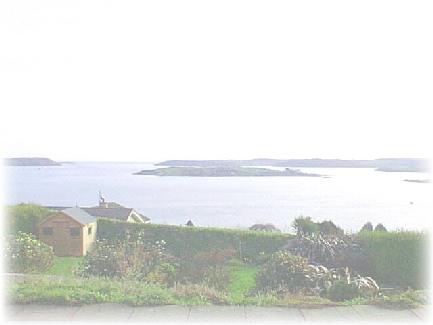| Images of Cobh | Cork Harbour |
Home | ||||
| View of Cork Harbour from The Anchorage in Cobh. Looking over Spike Island. .and out to Camden and Roches point. More |
 |
|||||
| Military history
of Cork Harbour as extracted from Michael Cronin article Camden Fort: Located on the west side of the harbour entrance, it was first fortified during the American war of Independence; remodelled during the Napoleonic period; used as a prison c1850-65; and remodelled again 1862 - c1874 first using contract but later military labour. Renamed Fort Meagher in 1938 and now owned by the Cork County Council. Carlisle Fort: Located on the east side of the harbour entrance, it has a history similar to Camden Fort except that convict labour was used for part of the remodelling in the 1860s. Renamed Fort Davis in 1838 and now owned by the Department of Defence. Haulbowline (or Haulbowling) Island: Located only a ½ mile from the centre of Cove, It has been occupied by the military for many years and was fortified in 1602. A permanent garrison was established there in the 1690 but in 1806, when it was decided to shift the army to Spike Island, it was appropriated to the Admiralty and Ordnance. On the eastern half of the island the Admiralty established the only naval arsenal in Ireland (large enough to supply the entire navy for one year). The west of the island was used as an ordnance depot that was closely associated with Rocky Island. In 1869 Haulbowline was upgraded to a naval dockyard (a major industrial facility for the repair and maintenance of ships). At its peak in 1918 it employed over 1000 shipyard workers. The dockyard was handed to the Irish Government in 1923. Spike Island (Fort Westmoreland): was purchased by the Government from Nicholas Fitton c1779 and fortified with a small 21 gun battery but it was the war against revolutionary France that saw the beginning of the major construction which, in 1790, was named Fort Westmoreland, after the then Lord Lieutenant, the Earl of Westmoreland. Construction continued throughout the period of the Napoleonic war at Westmoreland, Camden and Carlisle Forts. Opposition to the practice of 'transporting' convicts, most notably from the convict colonies themselves, saw a decline in transportation and the establishment of 'home convict depots'. In 1847 Spike Island and Philipstown (Kings County) were selected as male convict depots (females were accommodated at Fort Elizabeth in the city of Cork). By 1853 there were 3,764 male and 514 female convicts in Ireland of which c2,500 were on Spike Island. By 1860 this had dropped to 1,076 male (c500 on Spike Island), and 416 female. Intermediate prisons were also established at Carlisle and Camden forts but were closed by 1865. Prisoners were employed quarrying stone, building the Haulbowline Island docks, and construction work at Fort Westmoreland. The two Islands were connected by a causeway and wooden bridge for the duration of this work. The last prisoners were removed from Spike Island in 1885. Throughout the latter half of the nineteenth century all the forts were manned by elements of the Royal Garrison Artillery (often artillery militia) and were periodically updated with new guns. They survived the Great War without incident but by 1921 a bizarre situation had developed. By a clause in the Anglo-Irish treaty the harbour defences at Cork, Berehaven and Lough Swilly were to remain under the control of British Government and were known as the 'Treaty Ports'. They could neither be extended nor used during hostilities without the consent of the Irish Government, and the Government of De Valera was not cooperative. When the dockyard was handed to the Irish Government in 1923 the harbour was reclassified as 'a commercial port and naval anchorage of minor importance'. The harbour defences were eventually taken over by the Irish Government in 1938 at which time Fort Westmoreland was renamed Fort Mitchel, it is now owned by the Department of Justice. Rocky Island: A small island near Haulbowline, honeycombed with tunnels and used as a massive gunpowder magazine (25,000 barrels), it was designed to supply the whole of Ireland. An army detachment of one officer and 30 men was assigned to operate it. Fort Templebreedy: Located on the coast south of Camden fort it was built 1904-1909 and dismantled in 1946. It is now owned by the Department of Defence. |
||||||